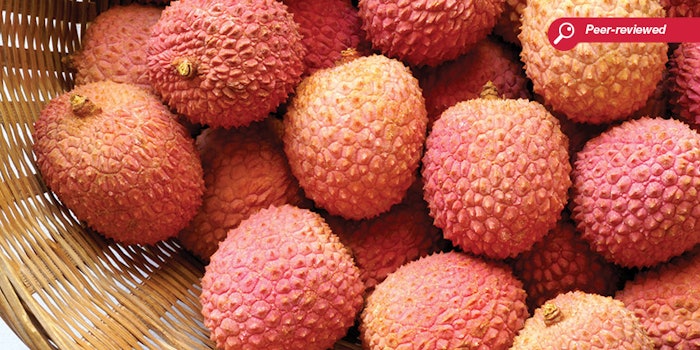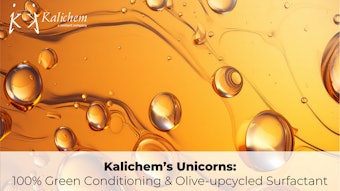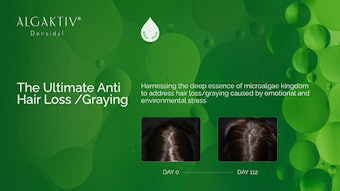
Read the full article in the March 2021 digital edition. . .
Litchi (Litchi chinensis Sonn.), or lychee, is a fruit with a particular flavor and taste that has long been used as a medicinal herb in several Asian recipes for weight control, lowering cholesterol and diabetes treatment. It also has an anti-inflammatory effect due to pharmacologically active phenolics, which have been shown to mitigate obesity-associated metabolic syndrome. Accordingly, it is widely cultivated in Asian countries including Thailand, as it is one of the country’s most important fruit crops, especially in Chiang Rai where the Emperor cultivar, a golf ball-sized fruit with a slightly acidic flavor,1 is cultivated as the signature fruit product.
Litchi is domestically commercialized and exported internationally. The amount of fruit processed tends to increase every year to meet growing demand, resulting in agricultural waste mainly of the peel or pericarp. The sustainable transformation of this litchi peel waste into a specialty ingredient for cosmetics affords an opportunity to meet consumer demand for natural cosmetics. This effort, in turn, would become an integral part of agricultural, environmental, food and cosmetic science, leading to a successive circular bioeconomy for litchi through its inclusion in eco-friendly, sustainable and natural cosmetics. As such, the current work examined the potential of litchi peel extract for skin benefits in vitro and in vivo, as described next.
In vitro Testing
Extract preparation: Litchi peel from the Emperor cultivar was collected from a local litchi processing factory. A standardized extract was then prepared by washing the peels with tap water, air drying under shade, oven drying, then grinding into powder for extraction; full details of the sample preparation process are described elsewhere.2
Antioxidant activity: In vitro, the extract was assessed for antioxidant activity by ABTS (2, 2'–azino-bis(3-ethylbenzothiazoline)-6-sulfonic acid), DPPH (1,1-diphenyl-2-picrylhydrazyl) and superoxide anion radical (O2•−) scavenging assays and compared with the standards.1-3
Anti-tyrosinase, cytotoxicity and anti-melanogenesis: Inhibitory effects of the extract against mushroom tyrosinase were assessed in comparison with kojic acid as the benchmark.1, 2 The cytotoxicity of the extract also was examined in B16F10 melanoma cells, followed by its actions on melanogenesis, tyrosinase and tyrosinase-related proteins-2 (TRP-2), tested at the determined safe concentration range.3
Phenolics content and analysis: The Total Phenolics Content (TPC) of the extract was analyzed by Folin-Ciocalteu assay.1, 2 In addition, the content of cosmetic active phenolics in the extract was determined by the validated UPLC method.1, 2
Test formulas: Finally, skin brightening serums incorporating the extract (or not, as the control) were developed (see Formula 1) and physicochemically evaluated and stability tested using a centrifugation assay and 7 heat/cool cycles.4, 5 The same formulas were then used for in vivo testing.
In vivo Testing
For in vivo testing, a study protocol, described next, following the Declaration of Helsinki and Tokyo guidelines for humans was developed and approved by the ethics committee of Mae Fah Luang University.
Skin irritation: The safety of the developed litchi serums was assessed in 29 Thai volunteers (20 female, 9 male) by a single application closed patch test for 24 hr on the volar forearms. Skin irritation severity was graded from 0-4 to calculate the Mean Irritation Index (MII). An MII < 0.2 was interpreted as negative or zero irritation. The base and litchi serums were examined in parallel with 0.5% sodium lauryl sulfate (positive control) and water (negative control).4, 5
Forearm skin brightening: A randomized, double-blind placebo-controlled study was conducted in 24 healthy female volunteers who applied one of the formula samples, i.e., the vehicle, or 0.05% or 0.01% litchi serum, twice daily, morning and evening, to their forearms to analyze potential skin brightening efficacy. The color of treated skin was measureda at baseline and after 2, 4, 8, 12 and 16 weeks (112 days) of application.4, 5
Facial skin brightening: In addition to the forearms, the potential brightening efficacy of litchi serums were tested on facial skin. Here, a split-face, randomized, single-blind controlled study was undertaken in the same group of volunteers, who again applied the 0.05% and 0.10% litchi serums twice daily. Efficacy was monitored in the same manner.4, 5
Sensory ratings: The litchi serums were rated by volunteers for their sensory characteristics using a hedonic scale from 1-5 (1 = dislike, 5 = most prefer) and interview questionnaires to calculate a final “preference percentage.”4, 5
Statistical significance: All parameters were compared and analyzedb using the t test and ANOVA test, at a significance of p < 0.05.
. . .Read more in the March 2021 digital edition. . .
References
- Kanlayavattanakul, M., Ospondpant, D., Ruktanonchai, U. and Lourith, N. (2012, Sep 10). Biological activity assessment and phenolic compounds characterization from the fruit pericarp of Litchi chinensis for cosmetic application. Pharm Biol 50(11) 1384-1390. https://europepmc.org/article/med/22889092
- Lourith, N. and Kanlayavattanakul, M. (2015, Nov 12). Preparation of the standardized fruit extracts with inhibitory effects against elastase and collagenase. Thailand Paddy Patent No. 10747. Int. Cl.10: C07C 7/10
- Lourith, N., Kanlayavattanakul, M., Chaikul, P., Chansriniyom, C. and Bunwatcharaphansakun, P. (2017). In vitro and cellular activities of the selected fruits residues for skin aging treatment. An Acad Bras Ciênc (89) 577-589. http://www.scielo.br/scielo.php?script=sci_arttext&pid=S0001-37652017000200577
- Lourith, N. and Kanlayavattanakul, M. (2019, Dec 26). Cosmeceutical product containing litchi peel extract. Thailand Paddy Patent Application No. 1803003007.
- Lourith, N. and Kanlayavattanakul, M. (2020, Mar). Formulation and clinical evaluation of the standardized Litchi chinensis extract for skin hyperpigmentation and aging treatments. Ann Pharm Fr 78(2) 142-149. https://pubmed.ncbi.nlm.nih.gov/32089252/
Captions/Footnotes:
a Mexameter MX 18, Courage & Khazaka
b SPSS program version 16.0, IBM











